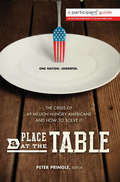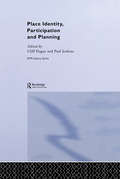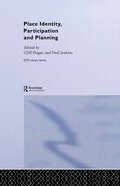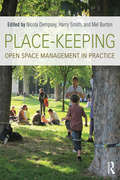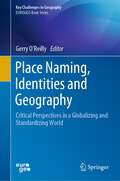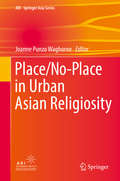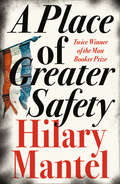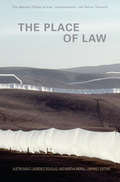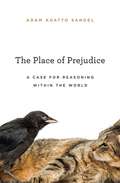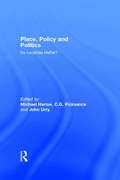- Table View
- List View
A Place at the Table: The Crisis of 49 Million Hungry Americans and How to Solve It
by Participant MediaForty-nine million people-including one in four children-go hungry in the U.S. every day, despite our having the means to provide nutritious, affordable food for all. Inspired by the acclaimed documentary A Place at the Table, this companion book offers powerful insights from those at the front lines of solving hunger in America, including:Jeff Bridges, Academy Award-winning actor, cofounder of the End Hunger Network, and spokesperson for the No Kid Hungry Campaign, on raising awareness about hungerKen Cook, president of Environmental Working Group, unravels the inequities in the Farm Bill and shows how they affect America's hunger crisisMarion Nestle, nutritionist and acclaimed critic of the food industry, whose latest work tracks the explosion of calories in today's "Eat More” environmentBill Shore, Joel Berg, and Robert Egger, widely-published anti-hunger activists, suggest bold and diverse strategies for solving the crisisJanet Poppendieck, sociologist, bestselling author, and well-known historian of poverty and hunger in America, argues the case for school lunch reformJennifer Harris, of Yale University's Rudd Center for Food Policy and Obesity, uncovers the new hidden persuaders of web food advertisersDavid Beckmann, head of Bread for the World, and Sarah Newman, researcher on A Place at the Table, explore the intersection of faith and feeding the hungryMariana Chilton, director of Drexel University's Center for Hunger-Free Communities, discusses the health impacts of hunger and the groundbreaking Witnesses to Hunger projectTom Colicchio, chef and executive producer of television's Top Chef, presents his down-to-earth case to Washington for increases in child nutrition programsAndy Fisher, veteran activist in community food projects, argues persuasively why we have to move beyond the charity-based emergency feeding programKelly Meyer, cofounder of Teaching Gardens, illuminates the path to educating, and providing healthy food for, all childrenKristi Jacobson and Lori Silverbush, the film's directors/producers, tell their personal stories of how and why they came to make the documentaryHunger and food insecurity pose a deep threat to our nation. A Place at the Table shows they can be solved once and for all, if the American public decides-as they have in the past-that making healthy food available, and affordable, is in the best interest of us all.
Place-Based Conservation: Perspectives from the Social Sciences
by William P. Stewart, Daniel R. Williams and Linda E. KrugerThe concept of “Place” has become prominent in natural resource management, as professionals increasingly recognize the importance of scale, place-specific meanings, local knowledge, and social-ecological dynamics. Place-Based Conservation: Perspectives from the Social Sciences offers a thorough examination of the topic, dividing its exploration into four broad areas. Place-Based Conservation provides a comprehensive resource for researchers and practitioners to help build the conceptual grounding necessary to understand and to effectively practice place-based conservation.
Place-Based Evaluation for Integrated Land-Use Management
by Johan Woltjer Ernest Alexander Matthias RuthIn recent years, there has been an increasing emphasis placed on local and regional integration in major planning projects and infrastructure development including roads, rail and waterways. This emphasis is not only on integrating various projects, but also integrating them with related issues such as housing, industry, environment and water. In other words, land-use planning and infrastructure management have become more spatially-oriented. This book brings together experts in the fields of spatial planning, land-use and infrastructure management to explore the emerging agenda of spatially-oriented integrated evaluation. It weaves together the latest theories, case studies, methods, policy and practice to examine and assess the values, impacts, benefits and the overall success in integrated land-use management. In doing so, the book clarifies the nature and roles of evaluation and puts forward guidance for future policy and practice.
Place-Based Evaluation for Integrated Land-Use Management
by Johan Woltjer Ernest Alexander Matthias RuthIn recent years, there has been an increasing emphasis placed on local and regional integration in major planning projects and infrastructure development including roads, rail and waterways. This emphasis is not only on integrating various projects, but also integrating them with related issues such as housing, industry, environment and water. In other words, land-use planning and infrastructure management have become more spatially-oriented. This book brings together experts in the fields of spatial planning, land-use and infrastructure management to explore the emerging agenda of spatially-oriented integrated evaluation. It weaves together the latest theories, case studies, methods, policy and practice to examine and assess the values, impacts, benefits and the overall success in integrated land-use management. In doing so, the book clarifies the nature and roles of evaluation and puts forward guidance for future policy and practice.
Place Branding and Marketing from a Policy Perspective: Building Effective Strategies for Places (Routledge Studies in Marketing)
by Vincent Mabillard Martial Pasquier Renaud VuignierAs part of an emerging literature on place branding, this book fills the important gap between practice-oriented literature—which lacks in-depth and critical analysis—and technical academic literature—which tends to miss down-to-earth practitioners' concerns and to overlook policy and political contexts. Providing frameworks and knowledge on how to practice place branding effectively, this book anchors place-branding practices in a solid analytical framework. It presents place-branding practices through the lenses of public sector marketing, strategic management, and governance processes and structures, as well as communication tools. Marketing a place is more than creating a logo and a motto; this book presents the key strategic aspects to be considered when promoting a place. Readers will gain knowledge about the most important features of place promotion: the development of brands and marketing campaigns in the public sector, the establishment of dedicated politico-administrative structures, and the increasing involvement of various stakeholders that play a central role as place promoters. This book will be a valuable resource for researchers and postgraduate students across place branding, marketing and management, and urban studies, as well as public management, administration, and policy. The practical conclusions discussed in the book will also appeal to practitioners, business consultants, and people working in public administration and politics.
Place Branding and Marketing from a Policy Perspective: Building Effective Strategies for Places (Routledge Studies in Marketing)
by Vincent Mabillard Martial Pasquier Renaud VuignierAs part of an emerging literature on place branding, this book fills the important gap between practice-oriented literature—which lacks in-depth and critical analysis—and technical academic literature—which tends to miss down-to-earth practitioners' concerns and to overlook policy and political contexts. Providing frameworks and knowledge on how to practice place branding effectively, this book anchors place-branding practices in a solid analytical framework. It presents place-branding practices through the lenses of public sector marketing, strategic management, and governance processes and structures, as well as communication tools. Marketing a place is more than creating a logo and a motto; this book presents the key strategic aspects to be considered when promoting a place. Readers will gain knowledge about the most important features of place promotion: the development of brands and marketing campaigns in the public sector, the establishment of dedicated politico-administrative structures, and the increasing involvement of various stakeholders that play a central role as place promoters. This book will be a valuable resource for researchers and postgraduate students across place branding, marketing and management, and urban studies, as well as public management, administration, and policy. The practical conclusions discussed in the book will also appeal to practitioners, business consultants, and people working in public administration and politics.
Place Identity, Participation and Planning (RTPI Library Series)
by Cliff Hague Paul JenkinsThe central concern of this book is place identity, and its representation and manipulation through planning. Place identity is of growing international concern, both in planning practice and in academic work. The issue is important to practitioners because of the impact of globalisation on notions of place. This book includes comparisons between Norway, the Netherlands, Sweden and Scotland, focusing strongly on the question of how different spatial planning systems and practices are currently conceiving and affecting issues of place identity.
Place Identity, Participation and Planning (RTPI Library Series #Vol. 7)
by Cliff Hague Paul JenkinsThe central concern of this book is place identity, and its representation and manipulation through planning. Place identity is of growing international concern, both in planning practice and in academic work. The issue is important to practitioners because of the impact of globalisation on notions of place. This book includes comparisons between Norway, the Netherlands, Sweden and Scotland, focusing strongly on the question of how different spatial planning systems and practices are currently conceiving and affecting issues of place identity.
A Place In The Sun: Marxism And Fascimsm In China's Long Revolution
by A. James GregorChina has endured a century of turmoil, beginning with the anti-dynastic revolution associated with Sun Yat-Sen, through the military and tutelary rule of Chiang Kai-shek, the revolutionary regime of Mao Zedong, and the radical reforms of Deng Xiaoping. China has had little respite. Historians and social scientists have attempted to understand some of this history as being the consequence of the impact of European ideologies-including Marxism, Marxism-Leninism, and Fascism. Rarely instructive or persuasive, the discussions regarding this issue have, more often than not, led to puzzlement, rather than enlightenment.In A Place in the Sun, A. James Gregor offers an interpretation of the role of European Marxist and Fascist ideas on China's revolutionaries that is both original, and based on a lifetime of scholarship devoted to revolutionary ideologies. Gregor renders a detailed analysis of their respective influence on major protagonists. In the exposition, Gregor reveals an unsuspected and complex set of relationships between the Chinese revolution and essentially European ideologies. His discussion concludes with a number of estimations that suggest implications for the future of modern China, and its relationship with the advanced industrial democracies. How post-Dengist China-the world's most populous nation-is to be understood remains uncertain to most comparativists and historians. Gregor provides one well supported alternative, and he is carefully attentive to the implications of this alternative.
A Place In The Sun: Marxism And Fascimsm In China's Long Revolution
by A. James GregorChina has endured a century of turmoil, beginning with the anti-dynastic revolution associated with Sun Yat-Sen, through the military and tutelary rule of Chiang Kai-shek, the revolutionary regime of Mao Zedong, and the radical reforms of Deng Xiaoping. China has had little respite. Historians and social scientists have attempted to understand some of this history as being the consequence of the impact of European ideologies-including Marxism, Marxism-Leninism, and Fascism. Rarely instructive or persuasive, the discussions regarding this issue have, more often than not, led to puzzlement, rather than enlightenment.In A Place in the Sun, A. James Gregor offers an interpretation of the role of European Marxist and Fascist ideas on China's revolutionaries that is both original, and based on a lifetime of scholarship devoted to revolutionary ideologies. Gregor renders a detailed analysis of their respective influence on major protagonists. In the exposition, Gregor reveals an unsuspected and complex set of relationships between the Chinese revolution and essentially European ideologies. His discussion concludes with a number of estimations that suggest implications for the future of modern China, and its relationship with the advanced industrial democracies. How post-Dengist China-the world's most populous nation-is to be understood remains uncertain to most comparativists and historians. Gregor provides one well supported alternative, and he is carefully attentive to the implications of this alternative.
Place-Keeping: Open Space Management in Practice
by Nicola Dempsey Harry Smith Mel BurtonPlace-Keeping presents the latest research and practice on place-keeping – that is, the long-term management of public and private open spaces – from around Europe and the rest of the world. There has long been a focus in urban landscape planning and urban design on the creation of high-quality public spaces, or place-making. This is supported by a growing body of research which shows how high-quality public spaces are economically and socially beneficial for local communities and contribute positively to residents’ quality of life and wellbeing. However, while large amounts of capital are spent on the creation of open spaces, little thought is given to, and insufficient resources made available for, the long-term maintenance and management of public spaces, or place-keeping. Without place-keeping, public spaces can fall into a downward spiral of disrepair where anti-social behaviour can emerge and residents may feel unsafe and choose to use other spaces. The economic and social costs of restoring such spaces can therefore be considerable where place-keeping does not occur. Place-Keeping also provides an accessible presentation of the outputs of a major European Union-funded project MP4: Making Places Profitable, Public and Private Open Spaces which further extends the knowledge and debate on long-term management of public and private spaces. It will be an invaluable resource for students, academics and practitioners seeking critical but practical guidance on the long-term management of public and private spaces in a range of contexts.
Place-Keeping: Open Space Management in Practice
by Nicola Dempsey Harry Smith Mel BurtonPlace-Keeping presents the latest research and practice on place-keeping – that is, the long-term management of public and private open spaces – from around Europe and the rest of the world. There has long been a focus in urban landscape planning and urban design on the creation of high-quality public spaces, or place-making. This is supported by a growing body of research which shows how high-quality public spaces are economically and socially beneficial for local communities and contribute positively to residents’ quality of life and wellbeing. However, while large amounts of capital are spent on the creation of open spaces, little thought is given to, and insufficient resources made available for, the long-term maintenance and management of public spaces, or place-keeping. Without place-keeping, public spaces can fall into a downward spiral of disrepair where anti-social behaviour can emerge and residents may feel unsafe and choose to use other spaces. The economic and social costs of restoring such spaces can therefore be considerable where place-keeping does not occur. Place-Keeping also provides an accessible presentation of the outputs of a major European Union-funded project MP4: Making Places Profitable, Public and Private Open Spaces which further extends the knowledge and debate on long-term management of public and private spaces. It will be an invaluable resource for students, academics and practitioners seeking critical but practical guidance on the long-term management of public and private spaces in a range of contexts.
Place-making and Policies for Competitive Cities
by Sako MusterdUrban policy makers are increasingly striving to strengthen the economic competitiveness of their cities. Currently, they do that mainly in the field of the creative knowledge economy - arts, media, entertainment, creative business services, architecture, publishing, design; and ICT, R&D, finance, and law. This book is about the policies that help to realise such objectives: policies driven by classic location theory, cluster policies, ‘creative class’ policies aimed at attracting talent, as well as policies that connect to pathways, place and personal networks. The experiences and policy strategies of 13 city-regions across Europe have been investigated: Amsterdam, Barcelona, Birmingham, Budapest, Dublin, Helsinki, Leipzig, Milan, Munich, Poznan, Riga, Sofia and Toulouse. All have different histories and roles: capital cities and secondary cities; cities with different economies and industries; port-based cities and land-locked cities. And all 13 have different cultural, political and welfare state traditions. Through this wide set of contexts, Place-making and Policies for Competitive Citiescontributes to the debate about the development of creative knowledge cities, their economic growth and competitiveness and advocates the development of context-sensitive tailored approaches. Chapter authors from the 13 European cities rigorously evaluate, reformulate and test assumptions behind old and new policies. This solidly-grounded and policy-focused study on the urban policy of place-making highlights practices for different contexts in managing knowledge-intensive cities and, by drawing on the varied experiences from across Europe, it establishes the state-of-the-art for both academic and policy debates in a fast-moving field.
Place-making and Policies for Competitive Cities
by Sako Musterd Zoltán KovácsUrban policy makers are increasingly striving to strengthen the economic competitiveness of their cities. Currently, they do that mainly in the field of the creative knowledge economy - arts, media, entertainment, creative business services, architecture, publishing, design; and ICT, R&D, finance, and law. This book is about the policies that help to realise such objectives: policies driven by classic location theory, cluster policies, ‘creative class’ policies aimed at attracting talent, as well as policies that connect to pathways, place and personal networks. The experiences and policy strategies of 13 city-regions across Europe have been investigated: Amsterdam, Barcelona, Birmingham, Budapest, Dublin, Helsinki, Leipzig, Milan, Munich, Poznan, Riga, Sofia and Toulouse. All have different histories and roles: capital cities and secondary cities; cities with different economies and industries; port-based cities and land-locked cities. And all 13 have different cultural, political and welfare state traditions. Through this wide set of contexts, Place-making and Policies for Competitive Citiescontributes to the debate about the development of creative knowledge cities, their economic growth and competitiveness and advocates the development of context-sensitive tailored approaches. Chapter authors from the 13 European cities rigorously evaluate, reformulate and test assumptions behind old and new policies. This solidly-grounded and policy-focused study on the urban policy of place-making highlights practices for different contexts in managing knowledge-intensive cities and, by drawing on the varied experiences from across Europe, it establishes the state-of-the-art for both academic and policy debates in a fast-moving field.
Place-Name Politics in Multilingual Areas: A Comparative Study of Southern Carinthia (Austria) and the Těšín/Cieszyn Region (Czechia) (Palgrave Studies in Minority Languages and Communities)
by Peter Jordan Přemysl Mácha Marika Balode Luděk Krtička Uršula Obrusník Pavel Pilch Alexis Sancho ReinosoThis book explores the role of place names in the formation and maintenance of individual and group identities in multilingual and multi-ethnic situations. Using examples from Austria and Czechia as case studies, the authors examine the power of place names through an interdisciplinary and multi-methods approach that draws from the fields of anthropology, geography, sociolinguistics and toponomastics. The book contextualises both places within their social and political histories, and probes recent debates in the social sciences relating to place names, identity and power. It will be of interest to scholars and students focusing on place names and naming practices, minority communities and languages, and linguistic landscapes.
Place Names of the World - Europe: Historical Context, Meanings and Changes
by J. Everett-HeathPlace names are a window into the history and characteristics of a country. Their names reflect the migrations of peoples, their religious and cultural traditions, local languages, conquests and fortifications long since disappeared. They also reflect the topography and industrial development of a place. The text is ordered by country alphabetically. The book will include a historical section, putting the place name into context, and references those events, which have had an impact on the geography of a country, and those foreign influences, which have played a part in shaping the place name. This volume is confined to the 38 countries of Europe, together with Andorra, Gibraltar, Liechtenstein, Malta, Monaco, San Marino, Cyprus and the Vatican City. All place names of cities and towns of particular importance and interest are included. Detailed maps accompany the text to illustrate change and evolution.
Place Naming, Identities and Geography: Critical Perspectives in a Globalizing and Standardizing World (Key Challenges in Geography)
by Gerry O’ReillyThis book presents research on geographical naming on land and sea from a wide range of standpoints on: theory and concepts, case studies and education. Space and place naming or toponymy has a long tradition in the sciences and a renewed critical interest in geography and allied disciplines including the humanities. Place: location and cartographical aspects, etymology and geo-histories so salient in past studies, are now being enhanced from a range of radical perspectives, especially in a globalizing, standardizing world with Googlization and the consequent ‘normalization’ of place names, perceptions and images worldwide including those for marketing purposes. Nonetheless, there are conflicting and contesting voices. The interdisciplinary research is enhanced with authors from regional, national and international toponymy-related institutions and organizations including the UNGEGN, IGU, ICA and so forth.
Place/No-Place in Urban Asian Religiosity (ARI - Springer Asia Series #5)
by Joanne Punzo WaghorneThis book discusses Asia’s rapid pace of urbanization, with a particular focus on new spaces created by and for everyday religiosity. The essays in this volume – covering topics from the global metropolises of Singapore, Bangalore, Seoul, Beijing, and Hong Kong to the regional centers of Gwalior, Pune, Jahazpur, and sites like Wudang Mountain – examine in detail the spaces created by new or changing religious organizations that range in scope from neighborhood-based to consciously global. The definition of “spatial aspects” includes direct place-making projects such as the construction of new religious buildings – temples, halls and other meeting sites, as well as less tangible religious endeavors such as the production of new “mental spaces” urged by spiritual leaders, or the shift from terra firma to the strangely concrete effervesce of cyberspace. With this in mind, it explores how distinct and blurred, and open and bounded communities generate and participate in diverse practices as they deliberately engage or disengage with physical landscapes/cityscapes. It highlights how through these religious organizations, changing class and gender configurations, ongoing political and economic transformations, continue as significant factors shaping and affecting Asian urban lives. In addition, the books goes further by exploring new and often bittersweet “improvements” like metro rail lines, new national highways, widespread internet access, that bulldoze – both literally and figuratively – religious places and force relocations and adjustments that are often innovative and unexpected. Furthermore, this volume explores personal experiences within the particularities of selected religious organizations and the ways that subjects interpret or actively construct urban spaces. The essays show, through ethnographically and historically grounded case studies, the variety of ways newly emerging religious communities or religious institutions understand, value, interact with, or strive to ignore extreme urbanization and rapidly changing built environments.
A Place of Greater Safety: A Place Of Greater Safety; Beyond Black; The Giant O'brien (4th Estate Matchbook Classics Ser.)
by Hilary MantelFrom the double Man Booker prize-winning author of Wolf Hall, Bring Up the Bodies and The Mirror & the Light comes an extraordinary work of historical imagination – this is Hilary Mantel’s epic novel of the French Revolution.
The Place of Ideology in Political Life (Routledge Revivals)
by D.J. Manning T.J. RobinsonFirst published in 1985, The Place of Ideology in Political Life explores the concept of ‘ideology’ in terms of its philosophical and intellectual underpinnings. Ideology is a term much bandied about by politicians and political thinkers with very little precision employed in its use. Despite acknowledgement in the literature of political studies that ideology plays a part in political life, there exist no precise accounts of the nature of that contribution. This book attempts to take a step towards redressing the balance by determining the sense in which ideology constitutes a genuine form of understanding human relationships and the place understanding has in all political activity regardless of whether or not any particular ideology is to be approved or condemned. This concise work will be invaluable to all students of politics, philosophy of action, ethics, and history of political thought.
The Place of Ideology in Political Life (Routledge Revivals)
by D.J. Manning T.J. RobinsonFirst published in 1985, The Place of Ideology in Political Life explores the concept of ‘ideology’ in terms of its philosophical and intellectual underpinnings. Ideology is a term much bandied about by politicians and political thinkers with very little precision employed in its use. Despite acknowledgement in the literature of political studies that ideology plays a part in political life, there exist no precise accounts of the nature of that contribution. This book attempts to take a step towards redressing the balance by determining the sense in which ideology constitutes a genuine form of understanding human relationships and the place understanding has in all political activity regardless of whether or not any particular ideology is to be approved or condemned. This concise work will be invaluable to all students of politics, philosophy of action, ethics, and history of political thought.
The Place of Law (The Amherst Series In Law, Jurisprudence, And Social Thought)
by Austin Sarat Lawrence Douglas Martha UmphreyIt has long been standard practice in legal studies to identify the place of law within the social order. And yet, as The Place of Law suggests, the meaning of the concept of "the place of law" is not self-evident. This book helps us see how the law defines territory and attempts to keep things in place; it shows how law can be, and is, used to create particular kinds of places -- differentiating, for example, individual property from public land. And it looks at place as a metaphor that organizes the way we see the world. This important new book urges us to ask about the usefulness of metaphors of place in the design of legal regulation.
The Place of Prejudice: A Case For Reasoning Within The World
by Adam Adatto SandelWe associate prejudice with ignorance and bigotry and consider it a source of injustice. Can prejudice have a legitimate place in moral and political judgment? Adam Sandel shows that prejudice, properly understood, is not an obstacle to clear thinking but an essential aspect of it. The aspiration to reason without preconceptions is misguided.
The Place of Prejudice: A Case For Reasoning Within The World
by Adam Adatto SandelWe associate prejudice with ignorance and bigotry and consider it a source of injustice. Can prejudice have a legitimate place in moral and political judgment? Adam Sandel shows that prejudice, properly understood, is not an obstacle to clear thinking but an essential aspect of it. The aspiration to reason without preconceptions is misguided.
Place, Policy and Politics: Do Localities Matter?
by Michael Harloe C. G. Pickvance John UrryThe past ten years have seen local government in the UK facing two major challenges: to survive in the face of Thatcher government hostility, and to adapt to enormously powerful forces of economic restructuring which have also been encouraged by government policies. The key aspects of these changing fortunes of British towns explored in this important new book is the ability of individual localities to exercise any control over their own growth and decline. Place, Policy and Politics examines local political initiatives seeking to influence economic and social development in seven sharply contrasting localities, ranging from the outer council estates of Merseyside to the boom towns of Cheltenham and Swindon. Throughout their analysis, the contributors, drawn from a wide range of social science disciplines, address the vital questions in the debate over local policy initiatives, including: * To what extent are localities able to harness trends in the national and international economy to provide jobs and a better standard of living for their inhabitants? * Why do local authorities vary in their capacity to initiate economic policy? * To what extent do national urban and other policies inhibit or encourage their efforts? * How might central government modify its policies to facilitate the prospering of localities?
